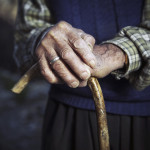I’m an HIV-positive woman pushing 50, and I’ve heard that HIV can spur bone loss. Can exercise help me stay stronger longer?
Dear Brittle,
Bones do weaken and become fragile as you age, increasing your risk of fractures. All women are prone to osteoporosis (“porous bone”) once menopause stops estrogen production; and positive women suffer bone thinning (osteopenia) at more than twice the rate of negative women. HIV also decreases testosterone levels, putting positive men at risk. Other bone-loss culprits for both sexes are corticosteroids, used to treat some HIV-related infections; smoking; and excessive alcohol consumption (more than about a drink a day for women, two for men).
Bone, however, can get stronger through exercise. Studies have established that weight-bearing routines are solid remedies for bone loss. For ideal bone-building, use light weights, performing many reps (three sets of 12 to 15 reps each). Some examples: bicep curls, lateral raises, tricep push-downs, flat-bench chest presses, squats, lunges and calf raises. Ask a trainer to show you how to do them properly.
You may also want to improve your balance, to help avoid bone-breaking falls. Go steady with yoga or any exercise that builds strong muscles—especially your abdominals, which keep you upright even when aging makes you wobbly.
If you flinch at the sight of dumbbells, don’t despair. Walking, jogging and stair climbing are good weight-bearing exercise alternatives. Try carrying one-pound weights or fastening light weights around your wrists when you walk.
Do any of these routines for 30 minutes a day and you’ll bone up for the long haul.
Jeffrey Gross is a certified fitness trainer based in Chicago. To suggest a topic for this column, e-mail trainer@poz.com.
SKELETON IN THE PANTRY
After you do your curls and squats, stock up on these bone-building nutrients
Four vitamins and minerals are mandatory daily for maintaining bone health.
People with HIV may need more than the standard recommended amounts listed below, so plan your daily dose with your doc. The first three can be found together in an array of foods. Add supplements as necessary:
calcium (1,200–2,000 milligrams)
vitamin K (90 micrograms for women, 120 for men)
magnesium (320 milligrams for women, 420 for men)
These three hang together in dark, leafy greens (collards, mustard greens, kale, Swiss chard, Brussels sprouts and broccoli) and in dried beans (Navy beans, baked beans, kidney and soybeans, black-eyed peas and chickpeas).
And don’t forget nutrient No. 4, vitamin D (400 international units): It’s found in only a few foods, but 15 minutes of sunshine a day prods your bod to produce it. Many people, especially those with dark skin, need supplements. Milk and other dairy products contain calcium, magnesium and D, but not vitamin K. Some juices are fortified with D as well. Bone appétit!







Comments
Comments